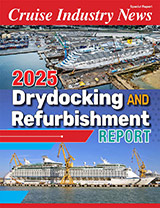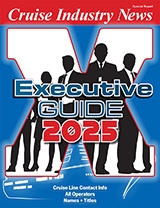The newly-formed Asia Cruise Terminal Association (ACTA) is taking its first step towards developing Asia into a “Caribbean of the East” with the convening of its inaugural meeting in Singapore.
Representatives from nine cruise terminals in Asia, including Subic Bay, Kobe, Sakaiminato, Xiamen, Yantai, Busan, Keelung, including Singapore Cruise Centre and Shanghai Wusongkou International Cruise Terminal arrived in Singapore over the weekend to attend a plenary session held at the Amara Hotel this morning. Initiated by Asia’s oldest cruise terminal operator, Singapore Cruise Centre Pte Ltd and Shanghai Wusongkou International Cruise Development Co. Ltd ACTA was formed as a regional forum for cruise terminal operators to cooperate in terminal development, operations and management, and to raise awareness of one another’s facilities and services. The aim is to create a “captivating cruise playground” in Asia, a region seen as having vast untapped potential for cruises.
In his keynote address, SCC’s chairman Soo Kok Leng said: “The timing for the formation of ACTA is ideal. The regional economy is back on track after the recent global financial crisis, and more cruise liners from around the world are setting their sights on Asia with more ships and more itinerary options for cruisers.”
Mr Soo noted that a forecast by independent UK-based consultancy, Ocean Shipping Consultants, put total cruise passenger throughput in Asia to reach two million in 2015.
“I believe that this forecast is too conservative,” he said. “It underestimated the economic growth in Asia and the pace at which the region’s middle class is growing. Assuming that only a tenth of the population in China, India, Japan, South Korea, ASEAN, becomes middle class by 2015, and cruising penetration reaches the US level of 3.2%, we will have about 6-7 million passengers cruising each year, or three times the number forecasted.”
Mr Soo said more Asians are flying to the US and the Caribbean for cruises and responding to the trend, major cruise lines are building more and bigger ships.
“Our longest-standing customer, Star Cruises, the world’s third largest cruise operator together with Norwegian Cruise Line, has new itineraries planned in 2011, with 12 of its 17 cruise vessels sailing within the region. They have also been actively marketing their Asian cruises to the Indian sub-continent and the Middle East, which is a relatively new passenger market for us. This is another growth potential,” he added.
“The challenge for the Asian cruise industry – terminal operators, cruise lines and supporting ground agents – is how to make Asia a more compelling cruise playground, how to attract more international cruise ships to come to Asia Pacific?” Mr Soo told the delegates.
He added that many cruise terminal operators in Asia are in the process of upgrading their infrastructure and raising the level of customer service to meet the needs of a more sophisticated market. They include Shanghai Wusongkou, the coinitiator of ACTA, which will be completing China’s largest cruise terminal at the mouth of the Huangpu River by early next year.
Incheon in Korea plans to complete a new international cruise terminal by 2014, in time for the next Asian Games. And the Port of Danang, Vietnam already has drawn up plans for a new ferry and cruise terminal. Hong Kong’s international cruise terminal is also being built right in the heart of the city and will be completed in 2013.
In Singapore, a new international cruise terminal will be completed by the end of 2011 which will effectively double the island’s cruise berthing capacity. Cheong Teow Cheng, SCC’s President/CEO, said: “We are very excited with the formation of ACTA. Asia’s cruise industry is on the cusp of growth as more and more holidaymakers recognise cruises as providing the best overall value in vacations.
“Through ACTA, Asia’s leading terminal operators will have a common platform for interaction, sharing of ideas and experience. The potential for growth is tremendous and through ACTA, we hope to put in place a set of best practices that will help all players in the industry benefit from the growth.”
Mr Cheong pointed out that currently only 0.05% of the 3.5 billion-population base in the Asia Pacific goes on cruise holidays. By comparison, cruise penetration in North America is 3.2% and in Europe, it is 1%. With Asia’s economy outpacing the West, the cruise industry here is also expected to continue to expand. Asia currently holds a 5% share of the world’s cruise market. The Asia Pacific region is expected to be the next engine of growth for the global cruise industry, byt providing new destinations for cruise passengers from the West as well as by being a new source of cruise passengers.
Since its incorporation five months ago, ACTA has already garnered 12 cruise terminal operators as members. They are: China (Shanghai Wusongkou, Xiamen, Yantai), Korea (Incheon, Busan), Japan (Kobe, Osaka, Sakaiminato), the Philippines (Subic Bay), Taiwan (Keelung), Vietnam (Danang), and Singapore (SCC). ACTA is also in talks with other terminal operators in the region to expand its membership.
Mr Cheong added: “By harmonising our operations and raising the service standards through ACTA, international cruise liners will be assured of a hassle-free and consistent experience at member terminals throughout the region. This will give them greater incentive to include Asia in their itineraries.”
Commenting on ACTA as well, Mr Lu Ming Qi, Chairman of Shanghai Wusongkou, said: “Promoting the cruise industry in Asia is a collective effort. Cruise liners do not just call at a single destination. Banding together as ACTA means we can better market the whole region as one destination.”
“Also, through ACTA, we hope to tap each other’s expertise and experience, and we will certainly look forward to this more when our international cruise terminal in Shanghai Wusongkou, the biggest in China, is completed March next year.”
Besides forming the Pro-tem Committee at its first plenary session, ACTA has plans to roll out joint marketing initiatives, conduct a best practices study, develop a manual on service standards, operational efficiencies, safety measures and conduct training for members



